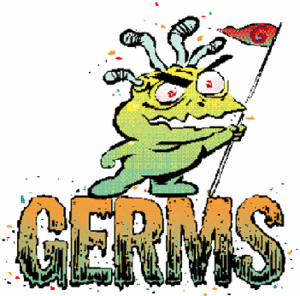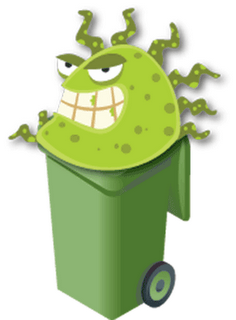
1. TV remote
Many people watch TV while they absent-mindedly chew their fingernails,
snack on food and flip through channels, leaving all kinds of bacteria
on
the remote. Make sure to sanitize the remote control regularly to prevent
sickness.
2. Tub and shower
Your bathtub may have 100 times more bacteria than the trash can,
according to an in-home bacteria study conducted by the Center for
Hygiene
and Health in Home and Community. The Hygiene Council recommends that
showers and tubs be disinfected twice a week to get rid of dead skin
cells
left in the tub that can carry germs too.
3. Pet food dish, bed, litter box
Most pet food dishes stay on the floor and do not get washed regularly.
Y'd think it'd only kill your PET, right? But the ones outside
the house
create mosquitos and NILE VIRUS breeds there. Use a rubber brush
on the pet bed, picks up hair. Once a week, shampoo pillow cover. And
use plastic bag on hand, to clean litter out of box daily, or twice
a day, and
once a week toss litter. If no pregnancy age women in the family, throw
the
litter (no turds) in back of garden and dig in. It is full of ammonia,
very
high nitrogen. But there is a feeling that at times there is a germ
that causes
birth defects in cat urine.
4. Kitchen cloths and sponges
People frequently use sponges or cloths to wipe germs from surfaces
in
the kitchen. As a result, 70 percent of kitchen sponges in U.S. homes
failed
the hygiene test by having high levels of bacteria, according to the
Hygiene
Council. The council recommends running sponges through the dishwasher
regularly and washing kitchen cloths on the hot cycle in the washing
machine.
5. Microwave touch screen
This spot is notorious for not getting cleaned. Even though the food
comes out cooked, the germs that can make you sick are left on the
outside of the
microwave for the next person to touch. It is important to wipe down
the
touch screen regularly, especially after cooking raw meat.
6. Light switches
Touching the light switch is practically unavoidable, but keeping it
clean is not. The bathroom light switch can have as many germs as the
trash bin.
Disinfect light switches twice a week, or every day if a member of
your
household is sick.
7. Baby changing table
During diaper changes, the baby wipes container, the diaper packaging,
the trash can and anything around the changing area get contaminated
with
bacteria through touching after handling a dirty diaper. The baby changing
table area should be cleaned often.
8. Kitchen faucets
Typically people wash their hands after handling raw meat in the kitchen,
but they touch the faucet to turn on the water and do not think about
the
bacteria that they leave. The Hygiene Council found more than half
of
faucets in American homes are covered in bacteria.
9. TRASH CAN INTERIORS
Years of the cooties off your meat packages collect in this sucker.
The
germs live from bottom to top, and every time you or the kids lift
the
lid, a cloud of microbial soldiers comes tromping out to be inhaled
into
your lungs. NOT a good thing. Take an old broom, a cup of bleach and
a hose running water, swoosh out its interior, all sides, turn on side,
get
the lid interior. Then let the bleach-water sit in it for a few hours
until the
bleach evaporates before you throw it on flower beds. Or dispose of
it
down the gully, the street. Bleach and all. Air pulls the toxic fumes
out of
the stuff.

FOR GERM CLEANING: VODKA, ON SPONGE. TOTALLY KILLS GERMS
FOR LAUNDRY: You grate up the Fels Naptha soap bar or
bars,
I use 6 bars of soap, 3 cups of the washing soda and 3 cups of borax.
I make a large batch. Lasts several months. It costs so much less that
commercial soaps.
I usually do larger loads of laundry with 3 tablespoons of this homemade
soap.
I also use 1/3 to 1/4 cup of distilled white vinegar as a rinse
agent. It
will take a while for the commercial softeners to be washed out
of your
laundry but when that does happen you can adjust the 1/4 or 1/3 cup
vinegar
in your rinse. a couple of my friends use a whole cup but i just
kept
trying until i got the laundry where i like it. I'm single and
on a low income
budget so every cent counts here.
*Super Washing Soda: This is not the same as baking soda. Baking soda
SHOULD NOT be used in place of washing soda. Washing soda is harmful
if
swallowed. It releases no harmful fumes, and is generally safe. Washing
Soda can
be found on the laundry detergent aisle of your supermarket. It comes
in an
Arm & Hammer 55-ounce yellow box.
10.) CARPETS
After all the rest is done and you are ready to go out to the park
for the day
Shampoo the CARPETS: These are lung filth factories. Vacuum
well then shampoo them.
My pal Timmy Ray told me "Yesterday I spent on my white Berber carpet
in the living room. After
cleaning all the adjacent tile flooring to avoid tracking any dirt
onto my soon-to-be wet
carpet, I finally got to using my Hoover "V" Steam Vac I'd gotten through
Costco about a year ago.
So easy to use and did a better job than Rug Doctor. Great suction
produced filthy water ladened with food particles, sand, dirt, and old
carpet fibers.Class A result. I was absolutely astonished at how fast it
dried...almost before I could the little Styrofoam blocks under the
legs of the furniture as I put it back. After about two hours I could not
find any wet areas. OK, I obsessed over my Hoover Carpet cleaner. Exciting
life, eh??
I asked him WHAT WAS IN IT? l0$ shampoo? Then it's not a free job. Me, I'd mix l0% amon/detergent and 90% warm water.
<=== BACK TO THE CLEAN HOUSE WEBSITE